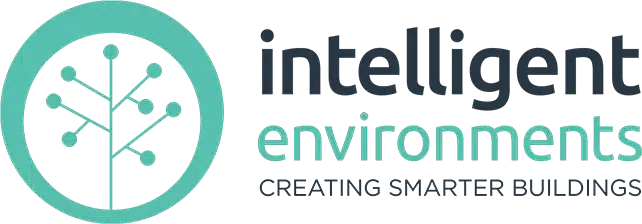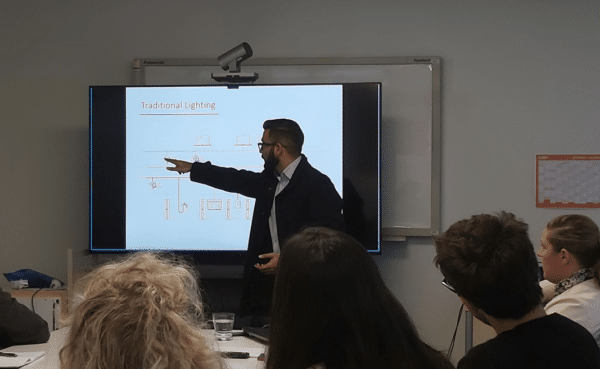A building management system (BMS) and a lighting control system (LCS) have historically served different purposes, but with recent advances in technology that now allows two-way feedback from the lighting control system on occupancy, temperature, air quality, and so much more.
There are an increasing number of scenarios where a lighting control system might make a BMS unnecessary, or less critical.
In our blog below, we challenge the myths around why a BMS may be deemed necessary and explain why in some situations, an LCS may provide all the functionality you require.

Myth Busting
(Click on any of the myths below to view the answer)
Is a lighting control system designed to just control the lights?
This question is similar to: A mobile phone designed to just make phone calls?
When mobile phones first came into being, the initial aim of this new technology was to allow phone calls to be made from any location. Today’s smart phones have evolved dramatically however to where they are today, with a myriad of systems, services and interfaces available at the touch of a button.
The growth of lighting control technology has been similar.
Initially lighting management was simply controlling the light output. Early methods of lighting control being simple dimming up or down of light levels.
As technology has developed, lighting control systems can now provide two way communication giving feedback from multiple devices, and providing information on much more than light levels. Such information may include occupancy, air quality, temperature, humidity, sound, pressure, and much more.
Advanced software and analytics allows comprehensive recording of building statistics, and enables the system to be adjusted to maximise energy savings and user comfort.
All this, and the lights can still be controlled (without the need for a building management system).
Do we need a BMS system to run the timeclock for the operation of the lights?
The lighting control system can seamlessly handle any requirements for schedules.
Our control systems incorporate smart devices equipped with an internal Real-Time Clock (RTC) offering support for timed triggers, and enabling the execution of pre-defined sequences at specified times.
Timed triggers can be configured to activate on specific days of the week, weekdays, weekends, and holidays. Furthermore, the smart device allows for the upload of local holidays, facilitating customized operations based on specific regional or local holiday schedules. Changes of for daylight savings happen automatically, and with no hassle.
Our zencontrol LCS also allows times to be adjusted or overridden remotely, should there be such a need. During the enforced lockdowns during the pandemic, many buildings relying on basic time clock control, continued to have the lights on for extended periods of time although the building was completely empty.
With this capability, users can set up timed triggers to automate actions or sequences according to their desired schedule, enhancing the convenience and functionality of the smart devices.
Will we need two occupancy sensors in the room - one to control the lights and one to control the HVAC?
A totally unnecessary and wasteful solution. Our zencontrol smart sensors detect occupancy, and can provide feedback to the BMS to switch HVAC on or off, as well as control the lights.
zencontrol multi-sensors are equipped with advanced technologies to provide feedback on eVOC, eCO2, humidity, motion, sound pressure, and temperature. All this in addition to IAQ (internal air quality) and light level measurement.
Your zencontrol LCS allows you to monitor air quality, control climate, optimise space utilisation, and save energy—all from a single, integrated system. Your toolkit for a safer, more comfortable, and energy-efficient environment.
Don't we need a BMS to see a graphical floorplan layout of any faults on the lights and emergency lights?
zencontrol Plan View allows facility managers and maintenance staff to easily understand the current state of your building devices with a glance at its floorplans. Faults and their locations can be quickly identified.
Issues are colour-coded and can be highlighted so that the most critical issues can be identified on the plan and rectified quickly.
Multiple users can even interact with your building simultaneously. Plan View is free and comes with your cloud subscription to a zencontrol LCS.
Can you have a smart building without a BMS?
You sure can!
A smart building, by definition, is a structure that leverages advanced technology to optimize its performance.
It is expected that the various building systems such as lighting, security, HVAC etc are integrated into a single, easily managed IT infrastructure.
Additionally smart buildings collect actionable data from user devices, sensors, systems, and services within the premises. The building should be programmable and responsive to the needs of occupants and building managers.
A smart or intelligent building should reduce operational costs by optimizing energy usage. For example, shades and artificial lighting responds to allow more natural light, significantly lowering electric lighting consumption. Energy costs are further lowered by connecting lighting, shades, and HVAC systems, so that temperature, lighting, and shades are adjusted based on occupancy and time of day.
Monitoring occupancy density allows automatic adjustment to building systems to adjust airflow, air quality and temperature. Thus ensuring user-comfort, and increasing efficiency. The collection and analysis of building data allows for continuous commissioning of the system: small tweaks and changes to ensure the building is operating at optimum.
All of these features can be supplied by a modern LCS. In a large building with vast HVAC mechanical services, it is likely a building management system will still be needed to manage the heating, ventilation and cooling. However with full integration to the BMS, a zencontrol system can handle all other requirements.
With smaller buildings, the expense of a BMS may not be justified. In these cases, a zencontrol system can provide all the features necessary to enhance energy efficiency, reduce costs, and improve the quality of life for occupants while maintaining security and sustainability – all the elements required for a smart building!
Will we need a BMS if we want to save energy?
Implementing a BMS can be expensive, especially for smaller buildings. A lighting control system may offer a more cost-effective solution for achieving energy efficiency and sustainability goals.
Lighting control systems are highly effective in reducing energy consumption. The LCS can incorporate daylight harvesting, occupancy sensing, and scheduling to minimize unnecessary energy usage. With a system like zencontrol, there are also savings in maintenance costs, and the costs of compliance (via automated monitoring, testing, and reporting).
Isn't a building easier to manage if it has a building management system.
Lighting control systems are usually easier to install, operate, and maintain compared to a full building management system. For buildings where simplicity is a priority, a lighting control system will likely be a more suitable choice.
Additionally, with a zencontrol system, maintenance becomes so much easier. The system tracks devices on the system and if a fault occurs the building manager can quickly determine if the faulty ballast, driver, etc is still under warranty, or when it was previously replaced. It can even track the number of hours that the light has been illuminated – perfect for those LEDs that are warranted for a certain number of hours, rather than a specific time frame.
When changes are needed, adjustments can be made very simply in-house, or remotely by the systems integrator. If maintenance staff change a faulty light or driver, remote assistance (if required) gets the system up and running with no costly site visits required.
If you are considering ways to make your building smarter to meet your organisation’s energy-saving and sustainability goals, or if you’d simply like to know more about innovations in building technology, please get in touch.


